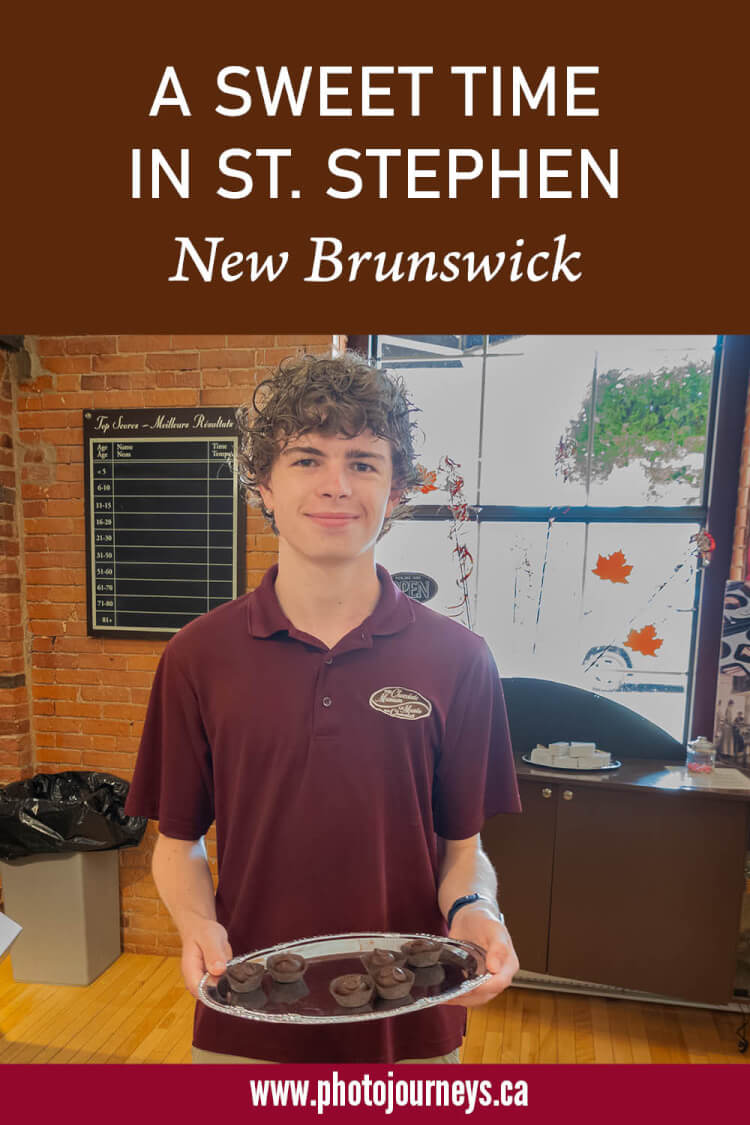
All photos © Robin and Arlene Karpan

If you like chocolate, don’t miss a visit to St. Stephen, New Brunswick, dubbed Canada’s Chocolate Town. You can take a stroll around Chocolate Park, drive down Chocolate Drive, and take a tour of the Chocolate Museum. Drop by in early August and you can even take in the annual Chocolate Fest.


For over 150 years the town of St. Stephen has been the headquarters of the largest family-owned and operated chocolate-making company in Canada – Ganong. It all started back in 1873 when brothers James and Gilbert Ganong settled in St. Stephen on the St. Croix River near the Bay of Fundy in southwestern New Brunswick, just a stone’s throw away from Maine across the river. They first operated a grocery store and introduced candy as one of the offerings. When demand for their confections grew, they turned their attention to making candy on a much larger scale. So began the Ganong legacy.

Chocolate Museum
There’s no better place to get the complete low-down on the chocolate-making industry than on a tour at the Chocolate Museum. Located in the same brick building in downtown St. Stephen that served as the Ganong factory until 1990, the 45-minute tour takes you behind the scenes to describe how chocolate making developed here and changed over the years. You also learn how some specialized traditions continue today.

Our guide Evan started the tour with a brief history of cacao from which we get the cocoa and chocolate we’re all familiar with. Now an everyday staple in most household pantries, it was once a prized commodity and was even used as currency in some civilizations. Spanish explorers introduced it to Europe and it soon became a popular drink with the elite crowd. Eventually it became available to the common folk and found its way into the candy-making industry.


Though he started small, James Ganong set the stage for a successful business. The company’s first runaway success was Chicken Bones, a product they started making in 1885 and continue to manufacture. The bright pink layer of cinnamon-flavoured ribbon candy covers a chocolate filling that melts in your mouth. Chicken bones are especially popular in eastern Canada, and usually show up in Maritime homes for the Christmas season.
“Would you like to try a sample?” asked Evan. “Sure,” we replied.

Evan paused at one display board with photos of all the company presidents, all members of the Ganong family. The longest-serving president (40 years) was Arthur Ganong who was a stickler for quality control. Apparently, he sampled every product every day, consuming between two and three pounds of chocolates or about 80 pieces. To balance the sweetness overload he walked everywhere, including to work every day.

Not only did the factory make chocolates, but they also manufactured jelly beans of every colour, specialty bars such as the Pal-o-Mine Bar that Arthur Ganong invented because he wanted to share treats with his friends (“pal of mine”), mints, and a long list of other confections. They also manufactured their own boxes, and packed everything onsite.
“Sample the Pal-o-Mine?” asked Evan. “Sure, why not.”
Hand-crafted quality
Hand-dipping chocolates is a specialized skill that lives on. Certain types of Ganong chocolates are still hand-dipped by ladies who have worked for the company for years. They work from a temperature-controlled tray of chocolate, cover each piece of soft candy by swishing it the chocolate bath, then lay it on a parchment-lined tray. Finally, a certain swirl or squiggle is added on top to indicate what flavour it is. The other advantage of hand-dippped chocolates? They can hold a lot more chocolate than those made by machine.

How do you tell if the chocolate you’ve selected is hand-dipped or not? Ganong uses a special type of parchment paper embedded with the company name on the drying tray. Turn your chocolate over, and if you see a portion of the Ganong name on the bottom, you’ve got the hand-dipped piece.
“Want to try a hand-dipped chocolate?” “Can’t wait!”
Heart-shaped boxes
The Ganongs were always on the lookout for new marketing techniques and opportunities. They first produced small boxes filled with chocolates so men could keep them in their suit pockets and bring them out at just the right time to impress their sweethearts with a tasty treat.
They were also the ones who introduced the heart-shaped chocolate box to Canada in the 1930s. Evan showed us some of the first ones they made, which they marketed during the Christmas season. The uptake wasn’t as high as they had hoped, so they re-issued the heart-shaped box for the Valentine’s Day market a couple of months later and business soared, becoming a Valentine’s institution. Of the many heart-shaped boxes on display, one huge one stands out. It was specially made for the company’s current president, Bryana Ganong, who was born on Valentine’s Day.

Another famous episode was president Whidden Ganong’s Christmas commercial. Apparently, Whidden didn’t enjoy appearing in endorsements, but agreed to do a commercial as long as it could be done in one take. And he nailed it, declaring “They may cost a little more, but they’re worth it!”
The tour continued with displays of items used at the factory in the early days before the company moved to its new building on 1 Chocolate Drive in 1990.

“Would you like to take home a small sample?” asked Evan at the end of the tour.
“What a great idea,” we said. All of us got a packet of chocolates as a souvenir token for taking the tour.
Then we made our way to the front of the original brick factory where we could shop at the Ganong Chocolatier. The choices were mind-boggling, ranging from the famous Delecto selection to artisan truffles, cherry cordials, peppermint creams, and more.
Seeing more of St. Stephen

After our chocolate fix on the tour, we needed to work off some pent-up energy. Almost across the street from the factory, we joined the Waterfront Trail which runs along the banks of the St. Croix River. The river is tidal, rising and falling as it fills with water from Bay of Fundy.

We stopped at the wharf where a small lighthouse stands next to the river. In the adjoining park, there are art installations in a floral garden, and a statue paying tribute to cartographer and geographer William Francis Ganong. The local tourist booth was open, and staff helped us pinpoint other places of interest in town.


We headed to the floral gardens at Dover Hill Park and saw the Milltown Cotton Mill Workers Monument a little farther along the river where a cotton mill stood for 75 years.


Finally, we drove to the 350-acre Ganong Nature Park, the former estate of Whidden Ganong which is now a preserve on the St. Croix Estuary. We walked some of the 11 kilometres of trail, including ones that border the former Ganong cottage overlooking the waterfront.

Chocolate Fest
In August, the annual Chocolate Fest is held which pays tribute to the town’s chocolate heritage. The Great Chocolate Mousse mascot is on hand at events such as the jellybean fun run, chocolate pudding eating contest, chocolate bar bingo, and choctail hour. You can even try your hand at hand-dipping chocolate. Who knows – you might have what it takes to hone your skills as a hand-dipper at the famous Ganong factory.

Resources:
- Check the Chocolate Museum for information on tours, prices, and times.
- The St. Stephen website has ideas for adventures, attractions, activities, and more.
- Excellent information at Southwest New Brunswick with ideas on things to do, guided experiences, etc.
- Tourism New Brunswick is the place to go to find details on other places to visit throughout the province.
Other articles on Photojourneys about New Brunswick that you might enjoy
- Photographing Puffins on Machias Seal Island
- Dulsing on New Brunswick’s Grand Manan Island
- Two outstanding Bed & Breakfasts in Fredericton
- King’s Landing – A Window to the Past
- Covered bridges of New Brunswick
- Exploring Cape Enrage
- Saint John, New Brunswick is a Delightful Mix of History and Nature
- St. Martins and the Fundy Trail Parkway
- Minister’s Island – Driving Across the Ocean Floor in New Brunswick
- Kingsbrae Gardens near St. Andrews
SUBSCRIBE to Photojourneys below
Feel free to PIN this article on A Sweet Time in St. Stephen, the Chocolate Town


